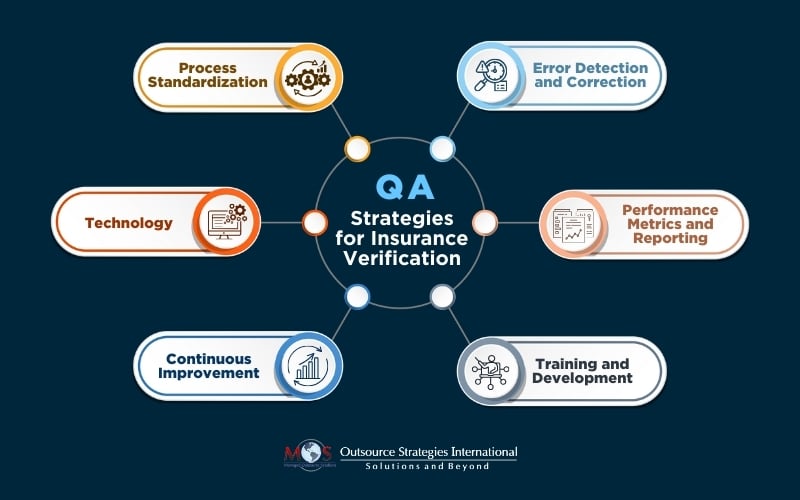Insurance verification involves obtaining accurate and up-to-date information from policyholders, healthcare providers, and other relevant sources to determine the eligibility and coverage for medical services. Compliance and Quality Assurance (QA) play vital roles in insurance verification, ensuring that the process is conducted accurately, ethically, and in accordance with industry regulations. Insurance verification services play a crucial role in supporting these requirements by ensuring that healthcare providers adhere to various industry regulations and requirements.
While the compliance aspect centers on adherence to regulations, quality assurance measures for insurance eligibility checks focus on ensuring accuracy and consistency in the application of verification procedures.

Compliance in Health Insurance Eligibility Verification
Regulatory Adherence
To be fully compliant, practices must adhere to the laws, rules, and regulations governing insurance and healthcare. Insurance verification processes must follow all applicable laws as well as local, state, and federal regulations to avoid legal issues. This includes regulations such as the Health Insurance Portability and Accountability Act (HIPAA) and the Affordable Care Act (ACA). These laws protect patient privacy, ensure data security, and establish guidelines for insurance coverage and claims processing. While following industry standards and best practices, insurance verification professionals need to always stay updated on changes in regulations and adjust their processes accordingly.
Data Privacy and Security
Compliance requires carefully safeguarding sensitive patient information during the insurance verification process. This includes the secure storage, transmission, and disposal of data as well as access controls and authentication measures to prevent unauthorized access. Compliance with data protection laws is crucial to maintain trust and avoid legal consequences.
To establish robust security, layered security is necessary, involving firewalls, intrusion detection systems, and continuous monitoring for real-time threat identification. Regular software updates and patching are crucial to prevent vulnerabilities.
Encryption protocols are also imperative for data security both in transit and at rest. Methods like Advanced Encryption Standard (AES) and Transport Layer Security (TLS) ensure data integrity and confidentiality. Maintaining effective encryption strategies depends on regular updates, audits, and training.
Access controls restrict data exposure. Role-based access controls, biometric verification, multi-factor authentication, and regular audits bolster security by restricting access to patient data based on individual roles within the healthcare organization.
Documentation and Recordkeeping
Compliance also requires that practices maintain accurate and complete records of patient eligibility verification activities, including communication with policyholders, healthcare providers, and payers. Regulatory authorities may audit these records for evidence of compliance with regulations.
Quality Assurance (QA) Measures for Insurance Verification
Implementing quality assurance in insurance eligibility processes includes process standardization, error detection to ensure accuracy and precision, reporting on performance metrics, and continuous improvement.
Process Standardization
QA involves establishing standardized procedures and workflows for insurance verification processes. Following consistent and standardized processes when collecting and verifying insurance information helps provide reliable and comparable results.
Error Detection and Correction
Proper QA also includes implementing mechanisms when verifying policy details, coverage limits, and other relevant information to detect/prevent errors or discrepancies. Regular audits, reviews, and quality control checks are conducted to identify and rectify inaccuracies, ensuring the verification process’s integrity.
Technology
New and proven technologies can enhance the speed, accuracy, and security of insurance verification processes, ultimately benefiting both insurers and policyholders. Examples include Electronic Data Interchange (EDI), Real-Time Eligibility Verification with Application Programming Interfaces (APIs) and Web Services; Blockchain Technology, Artificial Intelligence (AI) and Machine Learning (ML), Mobile Applications, and Cloud Computing.
Performance Metrics and Reporting
QA programs define key performance indicators (KPIs) to measure the effectiveness and efficiency of insurance verification processes. Examples of these metrics include the accuracy rate, turnaround time, and customer satisfaction. Regular reporting on these metrics allows for continuous improvement and performance evaluation.
Continuous Improvement
QA programs focus on continuous improvement by analyzing data, identifying trends, and implementing process enhancements. Feedback from policyholders, healthcare providers, and insurance companies can help identify areas for improvement and enhance the overall insurance verification process.
Training and Development
Ongoing training for staff is a critical aspect of an insurance verification QA program. Training develops their knowledge and skills, and helps them stay up-to-date on insurance policies, coverage guidelines, and changes in regulations to ensure accurate verification.

Want to learn more?
Check out our detailed exploration of the legal and ethical aspects of insurance verification: Legal & Ethical Considerations in Insurance Verification
Checklist for Health Insurance Verification: Integration of Compliance and QA Requirements
A compliance checklist is a proactive tool to ensure adherence to relevant laws, regulations, industry standards, and internal policies. Here are 10 crucial components of a compliance checklist for verifying insurance:
- Regulatory Compliance
- Adhere to applicable regulations such as HIPAA, ACA, and state-specific insurance laws.
- Protect patient privacy and ensure the security of personal health information (PHI).
- Obtain necessary authorizations and consents for the release of PHI.
- Insurance Policies and Coverage
- Verify the patient’s insurance coverage and eligibility for medical services.
- Understand carrier contracts, terms and conditions of different insurance plans, and billing processes
- Ensure compliance with insurance company guidelines and policies.
- Documentation and Recordkeeping
- Maintain accurate and complete records of insurance verification activities.
- Document all communication with policyholders, healthcare providers, and insurance companies.
- Retain records for the required duration as per regulatory and organizational guidelines.
- Data Security and Privacy
- Implement measures to protect PHI during the verification process.
- Use secure systems for data storage, transmission, and disposal.
- Restrict access to PHI and enforce appropriate authentication and authorization controls.
- Verification Process
- Establish standardized procedures for insurance verification.
- Verify patient demographics, policy details, and coverage limits.
- Cross-check insurance information with the insurance company’s records.
- Error Detection and Correction
- Conduct regular audits and quality control checks to identify errors or discrepancies.
- Implement mechanisms to correct inaccuracies promptly.
- Ensure accuracy in coding, billing, and claims submission.
- Training and Education
- Provide comprehensive training to all staff involved in insurance verification.
- Educate employees on insurance policies, coverage guidelines, and regulatory requirements.
- Keep staff updated on changes in insurance regulations and company policies.
- Performance Metrics and Reporting
- Define KPIs to measure the effectiveness of the verification process.
- Track metrics such as accuracy rate, turnaround time, and customer satisfaction.
- Generate regular reports to monitor compliance and identify areas for improvement.
- Compliance Audits and Monitoring
- Conduct internal audits to assess compliance with regulations and organizational policies.
- Monitor changes in regulatory requirements and update processes accordingly.
- Stay informed about industry best practices and integrate them into the verification process.
- Continuous Improvement
- Analyze data and feedback to identify trends and areas for process enhancement.
- Take steps for continuous improvement and encourage employee participation.
- Implement measures to improve efficiency, accuracy, and compliance.
Implementing quality assurance in insurance eligibility processes is exponentially easier with professional support. Insurance verification specialists can help healthcare organizations adapt this checklist to their specific policies, procedures, and regulatory requirements.

If you want to learn more about best practices,
be sure to read our post on Best Practices for Ensuring Accurate Insurance Verification
Professional Insurance Verification Services
Healthcare organizations are increasingly relying on professional support to navigate the intricacies of compliance and quality assurance for insurance eligibility checks. An experienced insurance verification company, we can help healthcare providers obtain accurate and up-to-date information about patients’ insurance coverage. Our experts perform patient eligibility verification to confirm whether the coverage is active and what services are covered. This helps healthcare providers offer appropriate services within the scope of the patient’s insurance plan, preventing potential compliance issues. It also ensures that they have the necessary information for billing and claims submission in compliance with regulatory standards.
“For multispecialty practices with more than one provider on site, our teams have experience with checking coverages for services that are categorized according to the appropriate provider/NPI to ensure those services get paid appropriately”, says Natalie Tornese CPC, OSI’s Director of Revenue Cycle Management, Healthcare Division. “Our teams audit on the back end to ensure the benefits we provide are accurate”, she explains.






